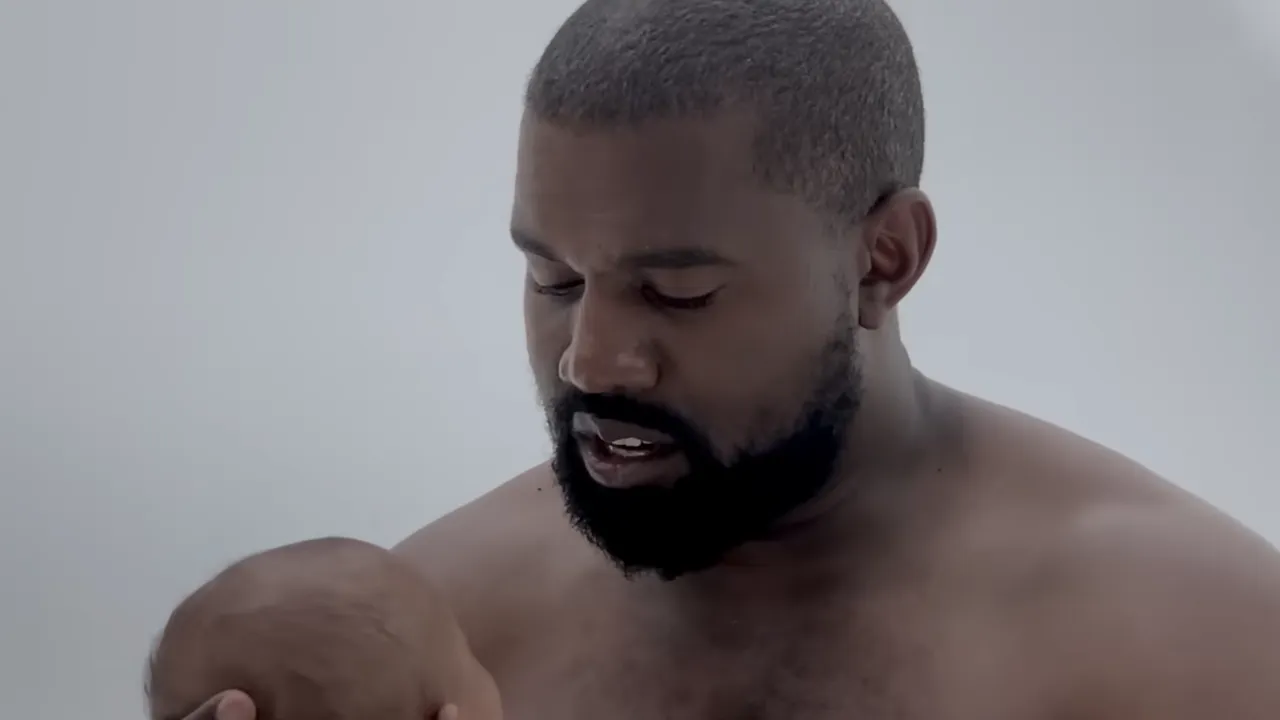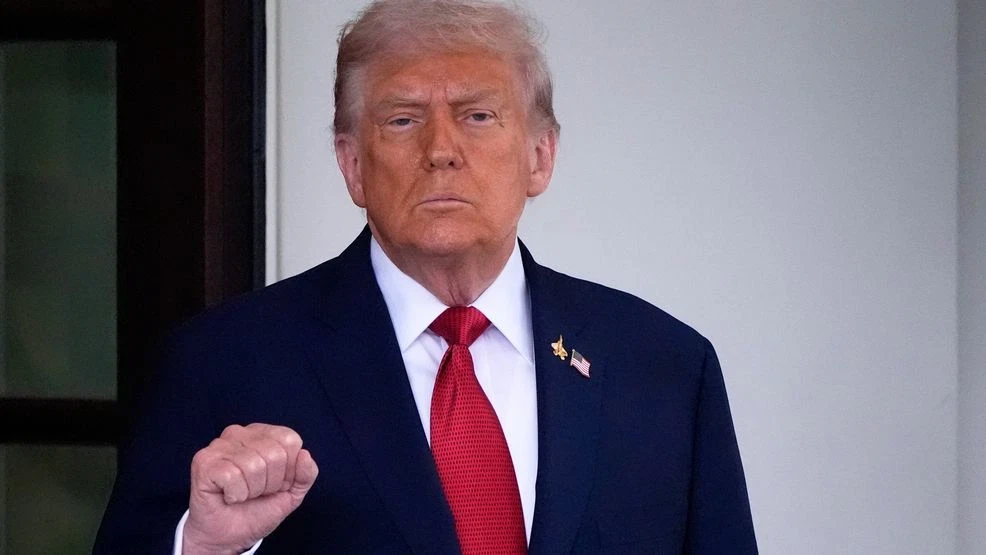
In March of this year, Ye, the artist formerly known as Kanye West, announced an “open casting call” to his thirty-three million followers on X. Anyone thinking of showing up for the casting call had plenty of reasons to be wary. Previous Kanye West music videos had included one in which he and the rapper Lil Pump wear ridiculous boxy costumes and impish grins while sexually harassing a gigantic Adele Givens; one in which Teyana Taylor performs a sweaty, semi-pornographic dance routine before turning into a catlike mythical beast; and one that depicts West sleeping next to nearly a dozen celebrity bedfellows, nude and snoring, including Taylor Swift, Anna Wintour, Bill Cosby, and George W. Bush—still the world’s wildest polycule a near-decade later.
But anyone who was still following West in 2025 had even more acute cause for concern, as the rest of his X post made clear. The casting call had five rules. West, a shock-jock poet on social media no less than in his music, spelled them out, with line breaks and expressive capitalization:
All males
NO FAT PEOPLE
The skin complexion of Sean Combs and darker
With shaved heads OR must be willing to shave head if approved
MUST BE COMFORTABLE WEARING SWASTIKAS.
He implied that the casting call would be for “Carnival,” a song whose attempts at boundary-crossing were so hoary (“She ride the dick like a carnival”; “Anybody pissed off, gotta make ’em drink the urine”) that, when it came out, no one paid much attention. In fact, he was apparently casting a video for another song, one that landed so squarely on a century-old third rail that it did get people’s attention: a recent single called “Heil Hitler.” In the video, thirty-five people stand in four rows, illuminated by harsh UV light, chanting the three-word earworm of the chorus. (The first word, maximizing both shock value and cognitive dissonance, is the N-word.) The first rule of the casting call seems to be in effect, but the second, fourth, and fifth appear to have been relaxed. Some of the men are shirtless. Others wear not swastikas but vaguely Nordic-looking animal skins. Their neck muscles flex with rage; the whites of their eyes shine in the black light. Even at the end, as the camera lingers on a guy in a wolf mask and archival audio of a fulminating Adolf Hitler plays in the background, you still can’t tell whether the whole thing was supposed to be scary or funny.
This was a particularly egregious example, but being toyed with in this way has long been a familiar experience to anyone who is or was a Kanye West fan—a category that includes, to some degree, anyone who takes popular music seriously, although some of us caught the bug especially hard. At his best as a beat-maker and producer, no one could match West’s preternatural talent and restless inventiveness. The one thing that could rival his gift was his own equally strong desire, or perhaps compulsion, to mar it, complicate it, or throw it away. He spent two years working on “All of the Lights,” arguably the most ambitious and meticulously crafted pop song since “Thriller”—only to give the featured rap verse to Fergie. “The Life of Pablo,” West’s 2016 album about his eternal struggle to deliver himself from evil, starts with a soaring six minutes of minimalist-maximalist gospel-rap—first the gorgeous “Ultralight Beam” and then the first half of “Father Stretch My Hands Pt. 1,” which sounds just as promising, until West jumps in to vandalize his own creation with some of the dumbest lines ever committed to tape (“If I fuck this model / and she just bleached her asshole / and I get bleach on my T-shirt / I’mma feel like an asshole”). In 2018, he released a charmingly soulful track called “Lift Yourself.” His verse on it goes like this: “Poopy dee scoop / Scoop dee dee whoop / Whoop dee scoop dee poop.”
Over about a decade and a half—beginning in the early George W. Bush years and ending, coincidentally or not, with the rise of Donald Trump—West released, both as a solo artist and as a producer for Jay-Z, Pusha T, and many others, one of the most consistently challenging and satisfying bodies of work in the history of pop music. This is a nearly peerless run, one that will earn him a place in the canon no matter how many asterisks he insists on appending to his legacy. (The Beatles, to take one example, were only in peak form for about six years—eight, tops.) Whatever else he does, West will likely be remembered as the best hip-hop producer who ever lived—an accolade that always struck him as an insulting underestimation of his many other talents. He didn’t want to be a mere music producer; he wanted to be a President, a pastor, a revered fashion designer, a master architect, a business mogul and visionary world-builder like Steve Jobs or Walt Disney. When none of that panned out the way he wanted, he took a heel turn. As he puts it on “Heil Hitler”: “So I became a Nazi—yeah, bitch, I’m the villain.” For those of us who cared deeply about West’s music, it’s hard to overstate what a loss this was. (If you’re a child of the sixties, imagine waking up to the news that Bob Dylan was actually a serial killer, or Nina Simone was a COINTELPRO plant, and you’ll have a rough idea.) To a casual consumer of tabloid headlines, West’s villain arc may have seemed like just another celebrity going off the deep end, or another provocateur trying to promote his latest project. But to us these were not mere provocations; they were betrayals.
One simple way to think of Kanye West is as a genius stuck in the body of a child who’s always on the verge of a tantrum. He takes out his crayons, scribbles on a napkin, then declares the result a masterpiece—and often, implausibly, it is—and yet he may tear up the napkin a few seconds later if his mood changes, or if he receives anything other than instant and unmitigated praise. In the new documentary “In Whose Name?,” an intimate chronicle of West’s long fall from grace, from 2018 to 2024, we see this pattern repeat again and again, at times almost literally. While being driven to the White House for a televised Oval Office meeting with President Trump, West, in much the same tone that he used while crashing Taylor Swift’s acceptance speech at the 2009 MTV Video Music Awards, shouts over his go-between, Jared Kushner, “I need to go the exact way that a foreign dignitary would go!” In Uganda, on a safari vacation with his then wife, Kim Kardashian, an entourage, and an extremely attentive security detail, West, wearing a bulletproof vest overnight and practically vibrating with paranoia (“I don’t feel comfortable here”), makes everyone pack up and fly back to the U.S. (One thing the documentary corroborates, if it wasn’t already clear, is that it took superhuman reserves of patience for Kardashian to stay married to West as long as she did.) He refers to “my mental health,” and to medication that he has been prescribed but has decided not to take. (The cover of his 2018 album “Ye” reads “I hate being Bi-Polar its awesome.”)
In Basel, Switzerland, he walks around with the architect Jacques Herzog, who showers him with platitudes about timeless spaces and organic forms. Then they sit for a meeting with some of Herzog’s associates, and West’s mood suddenly turns combative. He makes a few barely coherent remarks, then turns to one of Herzog’s female associates and demands her reaction. “Not what are you thinking—what are you feeling?” he says. “And when’s the last time you actually had a feeling?”
“I’m excited,” she says, sounding terrified, “because I want to understand who you are.” The backing score is a dirge-like drone, treating West’s casual bullying like the approach of a stalker in a horror film. At one point during this scene, West is sketching something (the shape of a roof?) and, at the merest insinuation that his sketch is not a masterpiece, he tears it up. “I’m not really asking your opinions,” he tells the architects that he has flown to Switzerland to meet. “I know I’m right.” He goes on like this for a while, adding, “I am Picasso.” Picasso was also a megalomaniac, but at least he was self-aware enough to stick mainly to visual art. In the documentary, West spends months flying around the world, talking about his plans to design a church, a school, a “sustainable city that runs off of air, fire, earth, and water”—almost everything except his plan to make another good album.
For now, the only way to see “In Whose Name?” is to go to a movie theatre. At an afternoon screening on opening weekend, the Regal Union Square was about half full. Most of the crowd seemed to be Kanye completists, maybe, but not Kanye loyalists, if there are any of those left. When they laughed, they seemed to be laughing at West, not with him.
We see him before he takes the stage at Soldier Field, in Chicago, wearing light-colored contact lenses and a black leather coat, looking like a surly teen who has been given a blank check and let loose in Hot Topic. (The effect is enhanced by the fact that he’s standing next to Marilyn Manson.) Backstage, after the show, West greets Elon Musk and escorts him into an empty, all-white room, which he describes as “the idea of a bedroom.”
“Interesting,” Musk says.
They lie down next to each other, looking up at the ceiling, then stand up and make awkward big-boy small talk. “So are you and Kim, like, off and on, or something?” Musk asks. He laughs, filling the time, then presses on: “Claire and I—Grimes—we’re sort of . . . In the same text stream, she’s, like, ‘I love you,’ and then like, you know, a day later, like, ‘I hate you.’ ”
“I don’t have answers,” West says, his whited-out eyes staring into the distance. “[I have] answers to everything except for that.” The audience laughed throughout this exchange, as if we were being treated to outtakes from “This Is Spinal Tap.”
Even when West’s home life is at its most placid, it continues to be risible. The house he shares with Kardashian, in Calabasas, is a mausoleum-like structure with marble walls and almost no furniture. It seems like a terrifying place to live, but it provides the perfect acoustics for Kenny G to come over and play “Over the Rainbow” on soprano sax, surrounded by long-stemmed roses, as West and Kardashian watch—one of the few domestic activities we get to witness, aside from screaming fights. On his way to celebrate Halloween with his kids, West says, “I’ve suffered so much trauma. The fact that I’m still here . . . every day is a blessing.” It’s hard to pay attention to his words, though, because he’s in a full-body costume, his face obscured by a dog mask. Later, when he sits for a remote interview on MSNBC, he is covered again, this time in a sort of tin-foil burka. A few seconds into the interview, feeling disrespected by the host’s innocuous questions, he tries to stand up in a huff and leave, but the drama of his exit is undermined by the slapstick sound of crinkling foil.
Throughout the documentary, he repeats the classic refrain of the petulant child: don’t tell me what I can’t say. He wears a red “Make America Great Again” hat, and the more it pisses people off, the more it seems to ramp him up. During a meeting at the offices of “Saturday Night Live,” where he is about to make his seventh (and, as of this writing, last) appearance as a musical guest, he tells the comedian Leslie Jones that his shilling for Trump isn’t really about Trump: “It’s about ‘1984.’ Orwell. It’s about mind control. It’s about Big Brother. It’s about: if I say the word Hitler, am I cancelled?” Not to spoil the rest of the movie, but the answer turns out to be: Yep, pretty much. We watch as West intersects with a parade of fellow-celebrities: Drake, Pharrell, Chris Rock, Candace Owens (accompanied by the late Charlie Kirk). Most of them tell him what he wants to hear. The few who have the backbone to stand up to him when he’s in the wrong—the comedian Michael Che, the producer Swizz Beatz, and Kardashian—get yelled at or dismissed. By the end of the documentary, West has squandered a few billion dollars, his marriage, and whatever remained of his reputation. Declaring himself “a bit of a masochist,” he insists, “I love this part of the movie.” That makes one of us.
Like most petulant children, West seems to be suffering from a lack of the one thing he really needs: a hug from his mom. Tragically, for the West family and for the world, Kanye’s mother, Donda, died unexpectedly in 2007. “Jeen-Yuhs,” a three-part documentary about Kanye that appeared, on Netflix, in 2022, includes a trove of footage of Kanye and Donda together, and she comes across as uncommonly lively and warm, the one consistently stabilizing presence in his life. In retrospect, losing her seems like the beginning of the end. His love-hate relationship with his faith—a constant theme in his work since he made “Lucifer” for Jay-Z, in 2003, and his own single “Jesus Walks,” in 2004—now seems inextricably wrapped up in her memory. “In Whose Name?” shows Kanye, years after his mother’s death, still flailing to reconnect with her: releasing “Donda,” an album with an all-black cover; buying his childhood home, on the South Side of Chicago, then sitting inside a replica of the house, onstage, while pretending to set it on fire.
The director of “In Whose Name?” is Nico Ballesteros, who talked his way into West’s entourage when he was a few months out of high school. Over the next few years, he shot about three thousand hours of footage, mostly on an iPhone. Structurally, the film is a bit of a cop-out—Ballesteros basically strings together the behind-the-scenes highlights, puts them in chronological order, and adds some portentous scoring and graphics, without any sustained attempt to show us what it all means. But that’s almost beside the point. Ballesteros got inside the shit show and came away with the goods. For the Kanye completists among us, that’s the main public service. Amid all the dark comedy and unrelenting bleakness in the film, there are a few moments of hope, almost all of which have to do with West making music again. He leads one of his Sunday Service performances, looking liberated; he stands next to a praying DMX, tears streaming down his face.
We’ve spent so many years asking what to do with the art of monstrous men that, by now, we all know at least part of the answer. As much as we may wish to separate the art from the artist, many of our most perverse and prolific art monsters won’t let us, because they keep making art about the most monstrous parts of themselves. You could articulate an argument, in theory, for why it’s O.K. to watch reruns of “The Cosby Show” without being troubled by what we now know about Bill Cosby. It would be harder to make a similar case for listening to Cosby’s 1969 standup album “It’s True! It’s True!,” which includes a track called “Spanish Fly.” Similarly, you can try to enjoy “Through the Wire” or “Flashing Lights” without thinking too much about the Ye we know now; but there is no neutral way to listen to “Black Skinhead,” a pre-downfall single that now sounds like foreshadowing, much less “Heil Hitler.” Besides, even if you try to set aside the lyrics of “Heil Hitler” and pay attention exclusively to the sound, it’s impossible to ignore the fact that the beat doesn’t knock the way, say, “Blood on the Leaves” once did. The low, rattling horns don’t hit as hard; the drums don’t sound as full. In the video, the black light looks cheap, and the animal skins look like they’re on loan from Party City. It would be a stretch to say that the worst part of the “Heil Hitler” video is its aesthetic laziness—the worst part, surely, is all the praise of Hitler—but it’s also true that the old Kanye would have been too proud to release something so chintzy.
After the end credits of “In Whose Name?” roll, we get one last glimpse of West, shirtless, holding one of his babies and singing an a-cappella version of “Use This Gospel.” The song appears on “Jesus Is King,” a short, uneven West album from 2019. That record never quite reaches the heights of brilliance that appear throughout each of his first seven albums, but at least he still seemed to be trying. Maybe one day he’ll try again. ♦



